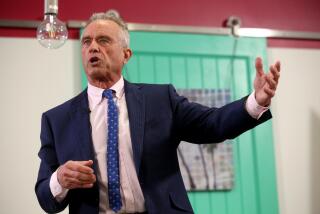Today, Trump said the L.A.Times poll ‘did a great job. Shocking...’ Here’s what you need to know
Reporting from Washington — Throughout the fall campaign, then-candidate Donald Trump and his allies loved the USC/L.A. Times “Daybreak” poll -- the only major survey that consistently showed him winning.
“A couple polls got it right. I must say Los Angeles Times did a great job, shocking because, you know, they did a great job,” Trump declared in his speech Friday morning at the Conservative Political Action Conference, an annual gathering of conservative activists.
But did the poll get it right?
In the simplest terms, no, and after considerable analysis, the pollsters at USC have a good sense of why.
The Daybreak poll, like any other survey, tries to forecast the actual vote. Its final national forecast had Trump winning 47% to 44%. In reality, he lost the nationwide vote, 48% to 46%. So instead of winning by 3 percentage points, he lost by 2, which made the poll less accurate than a number of other surveys.
And yet, the poll correctly forecast who would win the presidency, and it had the correct reason. As we wrote in late August, the poll was picking up a crucial signal: Trump had great appeal to disaffected white voters, many of whom sat out the 2012 election.
As it turned out, those white voters were just numerous enough to swing a few critical states -- Pennsylvania, Wisconsin and Michigan -- which nearly all surveys forecast Hillary Clinton winning.
So why did the USC/L.A. Times poll pick up that signal, but get the ultimate vote wrong?
The polling experts at USC who directed the survey have been studying that question since the election, and their analysis strongly suggests an answer: The poll sample had too high a share of rural voters.
That was an error, but in some ways a fortuitous one because it amplified the impact of precisely the voters who ended up delivering Trump’s victory in the key states.
When the pollsters initially put together the sample of voters they surveyed, they got a random sample of voters spread equally among the country’s ZIP Codes.
That’s a standard approach, but it has a potential flaw: ZIP Codes don’t all have the same population. More people crowd into the average urban ZIP Code than the average rural one. So if you draw equally from all ZIP Codes, you end up with too many rural residents represented.
Usually, that’s not a major problem. Polls are adjusted to make sure they have the right percentages of people of different ages, ethnicities, genders and so on, matching data from the census. That normally would erase any bias caused by having too many rural residents.
But 2016 wasn’t a typical year. Rural voters were distinctively more pro-Trump than those in cities and suburbs. Even the standard adjustments did not make up for the difference. Having the right share of 30- to 40-year-old white women, for example, isn’t enough if the voting preferences of rural white women differ significantly from those of urban white women, which was the case this time around.
When the pollsters looked back at their data and adjusted it to have the proper shares of urban and rural Americans, the data showed Clinton narrowly winning the popular vote, as she, in fact, did. Rather than a consistent Trump lead, the adjusted data showed Clinton leading most of fall, but the race closing to a dead heat in the final two weeks.
For more on Politics and Policy, follow me @DavidLauter
ALSO
One comment from Trump shows his administration’s message on immigration has been muddled
Trump reverts to campaigning a month into his term. This time, his opponent is the media
This Trump voter is torn between support for the president and an Obamacare plan that saved her life
More to Read
Get the L.A. Times Politics newsletter
Deeply reported insights into legislation, politics and policy from Sacramento, Washington and beyond. In your inbox three times per week.
You may occasionally receive promotional content from the Los Angeles Times.











